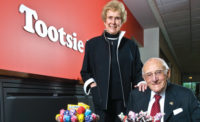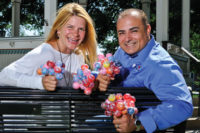“Destiny is no matter of chance. It is a matter of choice. It is not a thing to be waited for; it is a thing to be achieved.”
William Jennings Bryan,19th century American politician and orator
“I really think you can manifest your dreams. You can manifest your destiny. If you want something hard enough and you’re willing to work for it, I think you can get it. I truly believe that.”
Billy Magnussen, 21st century actor
When Doug Simons, president of Enstrom Candies, was asked to speak to the Opportunity Coalition in Denver last summer, he was both thrilled and honored. After all, the non-profit group comprised of business owners, executives, entrepreneurs, thought leaders and public servants from throughout Colorado, represented a who’s who of the state’s movers and shakers.
Moreover, as a music and theatre major in college, Simons has a bit of the thespian in him. Enstrom Candies hadn’t progressed to where it is without a certain amount of salesmanship and bravura. But in preparing his remarks, aside from jotting down some key bullet points about the company’s history, evolution and current status, he realized that showcasing a box of Enstrom Almond Toffee would be the perfect prop.
As he told the audience then, the box not only represented the “world’s finest candy,” it also contains “a legacy of knowledge, entrepreneurship, craftsmanship and dedication to the community.”
Heady stuff, but true nonetheless.
Of course, with the exception of family members in attendance, no one knew at the time that the box Simons was holding up was itself undergoing a transformation. The company, in fact, was in the midst of a rebranding program, one that would permanently alter its identity in the retail marketplace.
Founded in 1960 by Chet Enstrom, Enstrom Candies had evolved and built its success on producing a singularly delicious almond toffee, a premium confection that perfectly lends itself to gifting and the mail-order segment.
Doug and his wife, Jamee, Chet’s granddaughter, were instrumental in transforming Enstrom from being a “Mom-and-Pop” operation to the leading premium toffee maker in the United States. Thus, the decision to “rebrand” Enstrom to facilitate expansion into the wholesale confectionery segment was not taken lightly.
As expected, the process wasn’t an easy one either, albeit a necessary journey. Nor was it the company’s first attempt. As Simons explained in his employee newsletter, “You’re probably thinking, ‘we just did that,’ and you’re correct, we did, but we don’t think we got it right for a number of reasons.’”
Indeed, as Simons pointed out, “We were getting push back on our branded items because of the packaging.”
But it was more than just packaging.
“We wanted to analyze who we are, our history, where we belong in the category,” Simons says. “We have a great history, a great product, a great following. We needed to focus on our premium quality.”
Following a suggestion from Patrick Zachary, Enstrom’s director of manufacturing, Simons enlisted the help of DRC, a Chicago-based branding and marketing firm. In doing so, the entire Enstrom brain trust, including Doug, Jamee, their sons Doug Jr. and Jim, and key members of the management and support team, began the time-consuming process of self-examination.
“We started in March last year,” says Jim Simons, assistant to director of sales and Doug and Jamee’s youngest son. “We went through about 40 different options. For us, we wanted something that would pop on the shelf.”
And as Doug Jr., assistant to director of manufacturing, adds, “It’s not supposed to be easy; it was both heartache and fun.”
In the end, the team selected an orange-like color dubbed “Enstrom Gold” and a typeface that suggested “timeless elegance.”
But it wasn’t merely about choosing graphics; it also involved positioning.
“There was plenty of discussion about how this wholesaling effort was going to affect our mail-order business,” Doug says. “We had been very comfortable doing private-label since we were producing under a store brand name.”
The solution became clear: Retain the continuity of the new packaging and positioning — “the Gift of Timeless Elegance” — for both, but differentiate the two by size, texture and process.
As Doug explains, the mail-order toffee would continue to be made using Enstrom’s handmade toffee process, incorporating a layering of chocolate and a dusting of raw almonds on 2-ft. x 3-ft. slabs that would be first chilled, then hand-packed and finally frozen to ensure freshness and shelf life. And, as always, the mail-order business would continue to emphasize a full –service gift delivery program, ranging from custom sleeves to personalization of products.
The wholesale items would be made using the company’s automated toffee processing line, which focuses on producing bite-sized portions and doesn’t include any dusting of raw almonds. Those products would be geared for personal consumption as opposed to the mail-order segment, which emphasized “high-touch customer service.”
In truth, the wholesale effort would actually help further expand the mail-order business.
“By expanding our wholesale presence, we will be greatly expanding our reach,” explains Doug. “It’s really a fantastic sampling program whereby we expose more people to the quality of Enstrom’s.”
That quality is certainly seen in the manufacturing process, be it the traditional hand-made toffee process that goes back to Chet Enstrom’s days or the automated toffee line, introduced about seven years ago.
The handmade toffee process involves boiling water, pure cane sugar, butter and California almonds all together in six Savage kettles. Once the candy makers see that the toffee reaches a specific temperature and looks ready, the toffee is spread out onto water-cooled tables. The toffee is then spread to a one-nut thickness and cut into 2-ft. by 3-ft. pieces.
At this point, the toffee slabs are layered with signature blend chocolate and ground almonds. Once cooled the slabs are stacked onto special stainless steel racks where they undergo cooling. It’s then hand-packed and transferred to a freezer. Every batch is dated and coded, which allows for a first-in, first-out shipping process.
With regards to the automated toffee production process, supplied by Tanis Confectionery, the ingredients remain the same. It’s just the processing is that of a continuous batching system. Butter, sugar and water are combined to create a toffee slurry. Sugar is dosed from a one-ton tote automatically into a weighing vessel. An adjacent melter transforms 25-kilo chunks of butter into liquid, which also is pumped into the weighing vessel.
The slurry is then transferred into a buffer vessel for preheating. After undergoing a phase 2 heating cycle, the slurry goes to a finishing cooker. The almonds are sucked by vacuum via a hose from another 1-ton tote and delivered onto the emulsified toffee slurry continuously.
The toffee mass, which now includes almonds, gradually widens on a water-cooled steel belt until it reaches the prescribed width and then is slit and cut into bite-sized portions. A separator creates 13 rows of toffee candies while they undergo six different cooling zones.
Once cooled, the pieces are enrobed in chocolate, cooled and then feed into a flow-wrapper, which handles about 250 pieces per minute.
Next to the automated toffee line sits a Nielsen moulding line, which will be used to produce Enstrom’s newly launched truffles and “Belles,” chocolates with inclusions in them. The truffles, which will feature a range of cocktail flavors, such as Mai Tai, Malibu Rum, Irish Cream and Limoncello, were designed to not only affirm the company’s chocolate capabilities, but also differentiate them from existing truffle varieties on the shelf. The Belles will feature inclusions such as toffee and peppermint bits. The truffles will be twist-wrapped while the Belles will be bunch-wrapped.
“It’s all about exploiting our capabilities in the premium chocolate segment,” Doug says. “We are looking to take advantage of our abilities as a high-end candy maker.”
One of the most exciting developments regarding the new branding involves the “Bar in a Box” launch. Four pieces of chocolate-enrobed toffee will rest in a 3-oz. sized candy bar box, providing consumers with both indulgence and portion control. The item also introduces Enstrom into the chocolate bar/tablet sector with a unique offering. As Zachary points out, “It’s the item” for Enstrom’s branding campaign.
The company officially debuted its rebranding efforts at the Sweets & Snacks Expo, showcasing the new products, packaging and company identity in a new and larger booth. Enstrom’s foray into wholesaling, however, isn’t a new endeavor. The process actually had its roots back when Doug purchased Denver-based Stephany’s Chocolates out of bankruptcy back in 2006.
As Doug relates, he was made aware of Stephany’s Chocolates’ assets sales at the very last minute. He quickly decided to visit the facility and become involved in the bidding process.
“There was the bankruptcy attorney there, the owner of the building where Stephany’s Chocolates was located in, and me,” he explains. “Word was that Russell Stover had already made a deal to purchase Stephany’s. But when the auction began, the building owner made an offer. I then countered and raised the bid. The attorney for Russell Stover, who was on speaker phone, indicated he had to make a few phone calls and asked if we could wait a few minutes. Well, after 15 minutes of waiting, I told the attorney at hand that we needed to proceed with the auction. Just as we were speaking, the attorney from Russell Stover came back on the line. He said that Russell Stover wasn’t going ahead with its bid and wished Enstrom well with Stephany’s Chocolates.”
As Doug explains, his interest in purchasing the company was based on acquiring Stephany’s Chocolates’ two branded items, Colorado Almond Toffee and Denver Mint. In short order, Doug also purchased the building from the owner and started rehiring managers and employees previously working at Stephany’s chocolate.
“The goal was to expand our wholesale business,” he adds. “First, we would produce Stephany’s items, which had several good accounts with retailers in the Denver area.”
It was also during this period that Doug purchased the automated toffee line as well as the moulding line, the capital investments dovetailing with his idea of expanding into wholesale. Thanks to Doug’s dream of automating toffee production, he, together with the help of Leo Tanis, president of Tanis Confectionery, was able to get the line to produce toffee similar to the handmade process.
This labor of love, however, almost brought the company to its knees. First, the economy began to feel the aftereffects of the real estate bubble bursting in 2007, a precursor to the economic collapse in September 2008.
Second, the Stephany’s Chocolates operation was underperforming. And third, the switchover to automated toffee production, which increased efficiency and output, had revealed a serious miscalculation.
“When you produce toffee by hand, you actually microfraturing the surface by hand, creating tiny pockets for the chocolate to adhere to, creating a way for the toffee to bind to the chocolate. It’s something we really didn’t understand.”
That microfracturing played a key role in allowing the chocolate to stay bonded during the freezing process. In the automated toffee process, there was no handling of the toffee slab by hand; just enrobing.
As he found out after, the chocolate separated from the toffee because of the size of the pieces.
“We were getting calls from our customers, ‘What did you do to our toffee?’” Doug says. “Well, we quickly fired up the kettle and went back to producing all the toffees by hand, reshipping many of our customers’ orders again.”
The round-the-clock effort clearly identified to Enstrom’s customers that the owners kept their word: Satisfaction was always guaranteed.
“We took the heat for our mistake,” Doug says. In the end, however, the response cemented customer loyalty.
“We have a whole file full of letters from our customers thanking us for the effort,” he explains. “As one customer put it, ‘We didn’t know companies like yours existed anymore.’”
Nonetheless, the effort proved costly. The economic downturn, coupled with the investment in equipment and acquisition of Stephany’s Chocolates, proved fiscally challenging. With the recession in full swing, Enstrom shut down the Stephany’s Chocolates operation. Leasing and/or selling the building proved difficult, taking three years to do so.
“It was sheer fear that kept me going; I was not going to be the guy who took this company down,” he says.
Surprisingly, the perfect storm of calamities actually turned out to be a blessing in disguise, Doug adds.
“It taught us a hell of a lot,” he says. “First, we discovered that by producing smaller pieces of toffee on the automated line, we could enrobe the chocolate and ensure it adhering to the product. There’s enough tensile strength since it’s a smaller piece.
“And until that point, I was pretty bold and cocky. Seemed everything I touched turned to gold. Well, I learned some real lessons, and I’m not quite as cocky these days.
And as Jamee points out, “When we were first starting out, our financial advisor told us that ‘You don’t learn from your successes, but from your mistakes.’ He told us that we won’t believe it until we found out for ourselves, which was true.”
Those lessons learned proved incredibly helpful. In short order, the company was able to secure several local retail accounts as well as a few large, private-label accounts with major club stores.
“We were able to make great inroads into those sectors and we got healthy very quickly,” Doug says. “We were going and a blowing.”
That momentum took on another surge with the hiring of Patrick Zachary, former president and ceo of Zachary’s Confections in 2013, as director of manufacturing.
The title is a bit of a misnomer, says Zachary, as his duties encompass not just operations but sales as well.
As Doug admits, “His heart is in selling.”
Given Zachary’s connections to retailers and distributors as well as his 15 years’ experience within the industry, he adds another level of expertise into Enstrom’s expansion into wholesaling.
“Our core business, which is mail-order, direct to the consumer, has been growing at an annual rate of 3-4 percent,” he says. “The opportunity for growth, however, is in wholesale.”
Currently, Enstrom’s sales breakout is 70 percent mail-order and 30 percent wholesale. About 5 percent of the wholesale revenues are related to servicing the company’s five retail stores and two seasonal kiosks, which Jamee oversees.
Zachary looks forward to moving the needle forward for Enstrom’s wholesale effort. Not only is he excited about the rebranding — he was responsible for steering the company toward DRC — he is anxious to “hit the road,” to visit a cross-section of mass merchandisers, supermarket and drug store chains.
“Initially, I really believe our greatest opportunity is with seasonal,” he says, noting that no one out there really has a product like Enstrom’s. Moreover, he’s set a very high bar for his sales projections, nearly half of existing revenues, that is, $12 million.
As he explains, “I really wanted to hook up with someone where I could make a difference.”
But hitting sales targets isn’t Zachary’s only goal. He’s also involved in the “mentoring” process, which is transferring his experience and knowledge to the fourth generation: Doug Jr. and Jim.
In a way, that’s also a key element of the rebranding effort.
“The mail-order business is very seasonal,” Doug Jr. says. “We start making candy in May and start selling it in September. Otherwise, we’re twiddling our thumbs from January through May.”
The commitment to wholesale opened up opportunities for both Doug Jr. and Jim to learn the business. For example, although Doug Jr. is more inclined to handle manufacturing responsibilities, everything from learning how to run the automated toffee line to being the resident expert on the flow-wrapper, he accompanied Zachary and Bob Jackson, national sales director, on a sales call to a major mass merchandiser. Prospects look good for a regional test, he adds.
And Jim proved to be the point man for the company’s recent SQF Level 3 certification program, a key requirement for many retailers. As Jim explains, it took about 10 months. But thanks to the company’s already existing HACCP program, the certification process went relatively smoothly, requiring additional documentation to support its existing good manufacturing practices.
Moreover, as Zachary points, “Obtaining the SQF Certification was a key part to our strategic growth plan of expanding our wholesale business and continuing to explore private label and other opportunities. SQF is now the standard for doing business with industry’s high profile customers.”
So is a new plant.
“If things go according to plan, we’ll be in a new facility in two years,” Doug says. “We’re poised for a breakout moment.”
Naturally, the land’s already purchased. It’s just a matter of realizing that destiny.
See Also: Enstrom's Gives Back
At-a-Glance: Enstrom Candies
Headquarters: Grand Junction, Colo.
Plant: 55,000 sq. ft.
Employees: 80 permanent; 220 seasonal
Output: 4 million lbs. annually
Products: Toffee, also moulded chocolates, truffles, ice cream, toffee popcorn
Sales: $25 million (Candy Industry Magazine estimate)
Management team: Doug and Jamee Simons; Daniel Lively, IT/director of mail-order operations and warehousing; Mary Groves, cfo; Darla Fortner, director of human resources; Patrick Zachary, director of manufacturing; Doug Simons Jr., assistant to director of manufacturing; Jim Simons, assistant to director of sales; Bob Jackson, national sales director; and Brad Hector, regional sales.

































